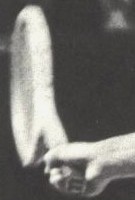Out of print, obtainable used from Amazon (link above).
Tennis Styles and Stylists covers the history of tennis from its origins to 1969. The book is loaded with excellent descriptions of how the game was played by its greatest players, including their grips (Continental, Eastern, or Western...) as well as their favored shots, services, and modes of attack. This well-written book is an excellent historical reference, and it does have an index. It also contains about 200 great photographs, placed amid the text of the book where the subjects are described, rather than in a separate section. Due to the focus of this website, the excerpts here deal with female players. But the bulk of the book describes male players, starting with the 1880s Renshaw and turn-of-the-century Doherty brothers, and running to the 1960s Laver, Emerson, Newcombe, Drysdale, and Ashe. All of the photos on this page are from the book.
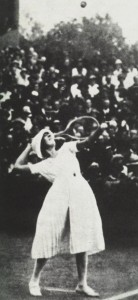 Suzanne Lenglen at her 1st Wimbledon in 1919 |
Suzanne Lenglen (pages 56-57) Never has one player, man or woman, achieved a degree of dominance equal to Suzanne's. Never have matches been so one-sided and yet so well-attended. It was all a matter of personality and play-- for this was the Incomparable Suzanne. Suzanne is one of the few women champions to have played in the English or Continental style. This style requires too much strength of wrist to be generally suitable for women players, the vast majority of whom are Easterners; even the Western style of using the same face of the racket for forehand and backhand is more popular and has remained in favour among the ladies far more than it has among men. Whatever power Suzanne lost by not having her palm and wrist behind the racket handle was made up for by her fine timing and weight control. A most graceful player, she was often referred to as the Pavlova of tennis. Powerful or not, she was a fast player and, particularly when at net, attacked the ball with vigour. She hit her forehand harder than her backhand, but her backhand was if anything the more accurate stroke. She smashed and served accurately, often placing a controlled second service for an ace... she was often restrained with the return of service, preferring to launch her attack later. Secure at all points in her own strokes, she concentrated on strategy. She had a game that was nearly perfect. |
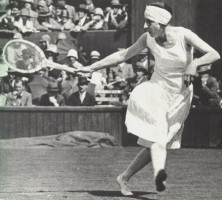 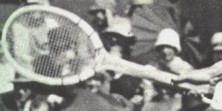 Suzanne's grip-- racket grip diameters of 5¼" were not unusual in the 1920s |
|
Suzanne Lenglen's influence on France's Four Musketeers [Jacques Brugnon, Henri Cochet, Rene Lacoste & Jean Borotra] is unquestionable; she was their "wonderful comrade and friend..." | ||
|
Helen Wills Moody (pages 70-71) Her play, though hard-hitting, was essentially feminine. There was no longer any need for women to look at Suzanne and sigh hopelessly; here was a new champion whose style remained within reach of the normal woman player. Learn to volley, ladies, so that you may hold your own at doubles, but in singles build your game on the baseline, which you can always cover. Take a good Eastern grip of the racket and make a decent swing so that you can get rhythmic power without needing great strength in your wrist. For the same reason, a substantial change for your backhand grip, and run your thumb up the back of the handle for support. Roll your strokes a little, for overall it is the least demanding method. Your speed of foot is limited, so develop your sense of anticipation as much as you can. For serving... throw the ball high enough to have ample time for a full and unhurried swing, and hit it from behind with plenty of weight and only enough sidespin to improve its chance of landing in court. This sidespin, for a lady, can be either from the slice side or it can be reverse spin. The sliced spin serves the ball wider on the forehand side and in general lends itself to accurate placing but the reverse service is the least tiring of all to make and it finds an opponent's backhand with far less strain than any other. Helen may not have proffered this advice in so many words, but her style elquently conveyed it... Helen's backhand grip |
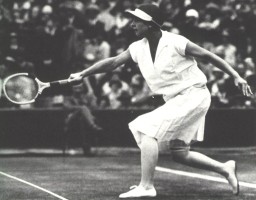 Helen Wills Moody 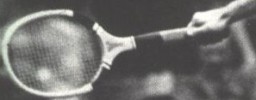
|
|
Alice Marble, Pauline Betz, Louise Brough, Margaret Osborne du Pont, Doris Hart, Maureen Connolly, Althea Gibson (pages 145-148) Between the wars there had been only one famous serve-and-volley lady player--the tall, blonde and shapely Californian, Alice Marble, who won Wimbledon in 1939 and her own country's championship four times. Then the graceful Pauline Betz, of Ohio, took over world leadership in her domain, and the baseline game, backed by deft volleying as the occasion arose, reigned supreme once more... ...Louise Brough, of Oklahoma, and Margaret Osborne du Pont, of Oregon, swept in, serving, smashing, and volleying severely, and using their ground strokes mainly to pave the way for net advances. From 1948 to 1950, Louise Brough, with her sometimes anxious court manner and sunny smile, was Wimbledon champion while Margaret du Pont, attractive and serene, was American champion. The two were close friends and they formed an almost unbeatable partnership, creating the most outstanding championship performance ever recorded by winning the U.S. ladies doubles championship nine times in succession, from 1942 to 1950, and a further three times in succession from 1955 to 1957. The Wimbledon doubles fell to them five times... Equal in skill to these two players and claiming the Australian championship (1949), the French (1950), and Wimbledon (1951) was Doris Hart... A classical stylist with sweeping and beautifully produced forehand and backhand drives, she made up in grace and power what she lacked in mobility [from childhood infantile paralysis]. An all-court player rather than a serve-and-volley specialist, she had a fast swinging service, strong volleys, and, for a woman, a severe overhead... |
more about Betz, Brough, Osborne du Pont, & Hart from 1946 TIME articles
more about Pauline Betz from The Game by Jack Kramer
There was no mistake about it though: Maureen Connolly hit the ball hard... ...she was naturally left-handed. A professional coach named Wilbur Folsom discovered her as a small ten-year-old hitting balls about with rare abandon with her left hand. It was Folsom who laid the foundations of her game [including converting her to a right-handed hitter] and arranged for her to be coached by Eleanor Tennant, known as "Teach" Tennant, former coach of Alice Marble... |
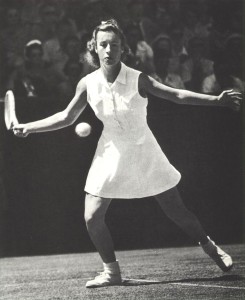 Maureen Connolly | |||
|
If Suzanne Lenglen, the all-court player of the 1920s was not the greatest woman player of all time, then "Little Mo," the battering-ram baseline player of the 1950s, would gain the vote of most critics. ...Serve-and-volley tactic reigned supreme in 1957 and 1958. Althea Gibson saw to that, by winning both the Wimbledon and U.S. singles in each year. | ||||
more about Maureen Connolly from 1951 & 1952 TIME articles
|
Maria Bueno, Margaret Smith Court, Billie Jean Moffitt King (pages 170-173) The three most outstanding ladies of recent times have been Maria Bueno of Brazil, Margaret Smith Court of Australia, and Billie Jean Moffitt King of America. The slender and dainty Maria Bueno was queen of Wimbledon and Forest Hills in 1959 and again of Wimbledon in 1960. Severe illness halted her career until 1963, between which year and 1966 she won her third Wimbledon and three more U.S. titles. Her strokes were as attractive as her appearance; very much an all-court player, she advanced to the net behind either flat rising-ball shots or a well-produced service to volley neatly and effectively. Margaret Smith became the greatest woman player in Australian tennis history, surpassing both Daphne Akhurst of the 1920s and the popular, hard-hitting Nancye Wynne Bolton, who had been Australian champion at the outbreak of the war and four times after it... Tall and rangy, she was somewhat coltish in her early career, making up with power what she lacked in smoothness and control. As she settled down into a tall and beautifully built world-class player of the net-attacking type, her backhand and volleying became nicely grooved and almost always reliable as well as strong. On service and forehand she hits the ball hard and appears a complete player, but, work on them as she would, these two shots (wild in her early career) have never responded sufficiently to be rock-like in crisis. ...No left-handed lady had yet won Wimbledon, but perhaps the performances of such great players as Little Mo Connolly and Margaret Smith [both lefties converted to play right-handed] provided the left-handers with at least a moral victory [Lefty Martina Navratilova would later win a record 9 Wimbledon singles titles]. Billie Jean Moffitt King does not possess the advantages of either the fleet-footed Maria Bueno or the tall and lithe Margaret Smith Court. Short, stocky and bespectacled, she seemed at first to be in a lower class than the other two, and likely to beat them only if either suffered a lapse. But Billie Jean, with her strong, compact ground strokes and her serve-and-volley game, has won the U.S. and Australian championships, and the Wimbledon title three years in succession. Margaret's backhand volley grip
|
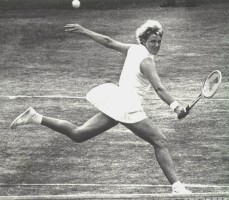 Margaret Smith Court 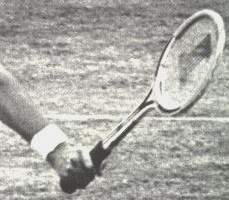
|
|
It thus seems, so far as tactics are concerned, that Little Mo Connolly's hard-driving baseline game, which dominated women's tennis on any type of surface in the early 1950s, was merely a temporary return to the past. In recent memory fast-surfaced championship women's tennis, like men's, has been most successfully played from the net position. | |
Find more books by or about Tennis History at Amazon.com
Find tennis shoes made by: adidas -- Nike -- Fila -- Reebok
Find tennis racquets made by: Yonex -- Wilson -- Head -- Prince -- Babolat
Find tennis balls made by: Wilson -- Dunlop -- Penn -- Tretorn -- Slazenger
Tennis pages at quickfound.net:
- Tennis Training Book Excerpts:
Tennis Styles and Stylists by Paul Metzler
Chrissie: My Own Story by Chris Evert with Neil Amdur
Courting Triumph by Virginia Wade with Mary Lou Mellace
The Game by Jack Kramer about Pauline Betz & Gussy Moran & more
Beyond Center Court: My Story by Tracy Austin with Christine Brennan
Courting Danger by Alice Marble with Dale Leatherman
Evonne!: On the Move by Evonne Goolagong with Bud Collins
Court On Court: A Life in Tennis by Margaret Smith Court
Goddess & the American Girl: Suzanne Lenglen & Helen Wills by Larry Englemann
Hard Courts by John Feinstein about Mary Carillo & John McEnroe & more
Ladies of the Court by Michael Mewshaw about Mary Joe Fernandez & more
A Long Way, Baby by Grace Lichtenstein about Rosie Casals
Monica by Monica Seles & My Aces, My Faults by Nick Bollettieri Seles at Bradenton
Tough Draw by Eliot Berry about Nick Bollettieri
The Courts of Babylon by Peter Bodo: Tournament Draws
The Courts of Babylon by Peter Bodo: Dawn of the Pro Tours
- Tennis Articles
1946 TIME: Pauline Betz, Doris Hart, Beverly Baker, Gussie Moran
plus current tennis article feed
1951 & 1952 TIME: Maureen Connolly - Tennis News and Links
- WTA 2004 Desktop Wallpaper
- Justine Henin-Hardenne Desktop Wallpaper
- Maria Sharapova Desktop Wallpaper
- Anastasia Myskina Desktop Wallpaper
- Anna Kournikova News and Links
- Anna Kournikova Desktop Wallpaper
- Martina Hingis News and Links
- 2004 WTA Player Interview Videos
This page's URL is: //tennis.quickfound.net/history/tennis_styles_and_stylists.html
